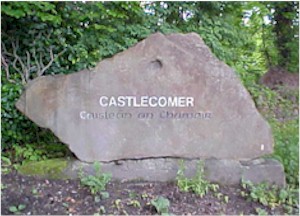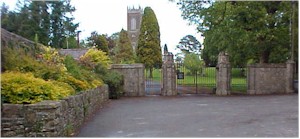 |
Locality
 |
The town of Castlecomer is situated in the southeast of Ireland, twelve miles from the historic city of Kilkenny. Castlecomer is a town of 2093 inhabitants and indeed is a historic town in its own right. Until the 16th century, Castlecomer or comer as it is locally called was the home of the O’Braonáins. In 1635 Thomas Wentworth, earl of Strafford planted an area in Co.Kilkenny with six hundred Yorkshire men. Christopher Wandesforde was granted an area round the present town of Castlecomer. Castlecomer and the surrounding area was owned by the Wandesfords until the present century.
The
Brennan Clan came into existence over a thousand years ago when Braonán the son
of Cearbhall, Viking King of Dublin settled in the area of north Kilkenny, then
known as Idough. Until the coming of the Normans in the 12th century
the Brennans were the most powerful clan in the area, having defeated all local
opposition.
In
the 17th century the Brennan lands were granted to Christopher
Wandesforde and the Brennans lost all legal rights to their lands.
Because of the historical value of the Brennans as part of Castlecomer history the local Fassidinin History Society in 1989 decided to hold a “Brennan Clan gathering” They hoped to unite all Brennans and bring them together from all over the world. This gathering was staged in Castlecomer and surrounded parishes from Friday September 21st 1990. Due to its success another clan gathering took place from June 23rd-25th 2000 to celebrate the 10th anniversary of the first clan gathering.
|
|
The Big Bridge across the Deen is so called to distinguish it from Clohogne Bridge. The bridge is built at the junction of the Deen and Brokagh Rivers. This meeting is in Irish “cumar” from which Comer takes its name. The moat of the Castle of Castlecomer was formed within the angle of those two rivers. This excellent structure was erected in 1763, when the existing bridge was demolished. When you cross over this hump back bridge the view opens up into a large pleasant elegant square surrounded by lime trees. Often in summer months if you stand on the bridge you can see young people swimming and angling.
The home of the Wandesford’s, this magnificent building was built in 1640 by Sir Christopher Wandesford on the site of Castlecomer Castle. The house was modelled on a colonial style and is reputated to have had 365 windows one for each day of the year. It was destroyed by fine on the 24th of June 1798 and was rebuilt by Lady Anne Ormonde in the early 1800’s. The Wandesford family ceased occupying the house in 1967 and the building was damaged by fire and partly demolished in 1975.
Antracite coal was first discovered here by accident in the late 1630’s in the iron ore mines which were given to Sir Christopher Wandesford. Castlecomer Coal was highly valued and was used in various industries; malting, milling, grain drying, wool drying, lime burning, steam rising to heat large public buildings and offices. It was widely used from ordinary houses to express locomotives. Castlecomer coal was sold within a twenty mile radius of the colleries and the coal was transported by horse and cart.
Commercial mining was important for Castlecomer. It meant money for locality. Irish families such as the Brennans became coal miners and wood hauliers rather than cattle herders. Coal helped to start the building of roads and rid the locality of historical isolation.
To find out more about Coaling in Castecomer visit the following website:
The Deerpark Marian shrine was erected by the workers of the mines to commemorate the Marian year of 1954. It originally stood at the mouth of the tunnel in the pit yard. In 1967 it was re-erected on the Castlecomer/Clogh road on a plot of ground kindly donated by the Boran family.

The
Church of the Immaculate Conception
(The
Catholic Church)
|
|
The church of the Immaculate
Conception is situated on Kilkenny St. The foundation stone of this church was
laid on the 16th of August 1844 and completed in 1852. William Dean
Butler designed it. The church is of gothic style with many beautiful things to
be seen. The Stations of the Cross are special in that they are
three-dimensional. There is a beautiful marble altar in the sanctuary along with
a very decorative marble ambo. There are some beautiful statues in the church.
At the moment funds are being raised to redecorate the interior of the church.
St Mary’s Protestant church
 |
St Mary’s church is situated outside the town on the main Dublin road.
Christopher Wandesforde built this church. The steeple of the church can be seen
peeping through the trees that surround it, and it appears in sketches as far
back as 1832.
Visit www.castlecomer.net
to find out many more interesting things about our
locality.
| Recycling | Music | Newsletter | Pres. Order |
| History of our school | Mission Awareness | Children's Work | Activities |